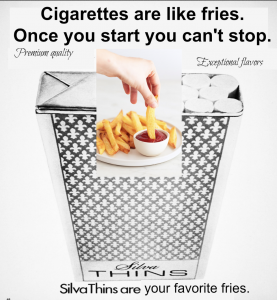Original Ad

Original Ad
This ad is a vintage tobacco advertisement from the 1970s that clearly objectifies women and portrays women as inferior to men. Through the use of figurative language comparing women bodies to cigarettes and an illustration of a women leaning against a man, the ad puts women into a submissive stereotype and implies that women are nothing more than their bodies.
The bold heading plastered across the top of the ad states “Cigarettes are like women. The best ones are thin and rich.” By comparing cigarettes to a woman’s body, the ad completely objectifies women. The ad strips women of their human characteristics and misrepresents how women should be perceived. What about a woman’s intelligence? Her values and personality traits? Why is a woman being valued only on by her appearance and income? These questions show that the ad sets unrealistic and incorrect standards for women – that a woman should be tall and thin in order to be the “best” and that only a woman’s body speaks for her value.
The picture under the heading shows a tall, blonde woman leaning against the shoulder of a man. The man wears a suit and sunglasses with a cigarette in his mouth, while the woman wears a short white skirt showing off her long, slender legs. The man looks straight ahead with his arms crossed and feet in a wide stance emanating confidence, power, and status, whereas the woman has her legs crossed and looks up at the man. The body language shows that the woman is submissive to the man and is his “accessory,” like the cigarette in his mouth. She leans on him for support suggesting she is inferior and powerless. From the body language and clothing of the man and woman, the ad clearly suggests that women are inferior to men.
This ad objectifies women and unfairly classifies them based on their bodies. It sets unrealistic standards for women – that they must be thin in order to be the best. It misrepresents women for who they truly are by ignoring woman’s intelligence and other human characteristics. The ad even implies that women are inferior to men and merely just a man’s “accessory”. It is unfortunate to know that ads have majorly influenced our perception of women today and even nowadays, it is not uncommon to see an ad objectifying or sexualizing females.
Jammed Version of Ad

Jammed Version
This jammed version of the ad completely eliminates female objectification and any implication of female inferiority. The main change was to replace the controversial heading and image and add subtle modifications to support the ad’s new fresh look.
The premise of the original ad was to illustrate that Silvia Thins are a better cigarette brand than other brands. By changing the original comparison between the female body to a cigarette to a comparison between fries and cigarettes, gender neutrality is established, and we shift our perspective of Silvia Thins in another light while giving the same message. Fries are everyone’s guilty pleasure and we all have our own favorite kind. By stating that Silvia Thins are “your favorite fries,” we advertise that Silvia Thins are the best, like the message of the original ad. The ad lets consumers decide their favorite fries, rather than dictating the standards of what is the best fry.
Why I chose to use fries as the subject of the ad is because fries are universally loved and everyone knows that they are addicting and not good for you. This makes the perfect metaphor, as cigarettes are also addicting and not good for you. Moreover, fries are not offending, do not objectify any human in any sort of way, and do not make one inferior to another.
There are so many ways to get a message across an advertisement that I think it is utterly unnecessary to have to sexualize or objectify females to attract consumers. We live in a society where these views still exist, because we are constantly fed these ideas.